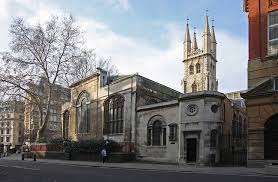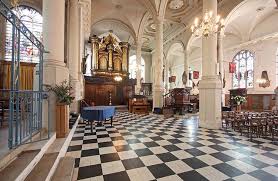
 PIN
St. Sepulchre (Holborn)
PIN
St. Sepulchre (Holborn)
A teeming collection of history and myth
St. Sepulchre-without-Newgate is the largest parish church in the City of London with an important place in London`s history dating back to 1137. This history includes a connection with John Smith (adventurer and close friend of Pocahontas), the city’s first public water fountain and an ‘execution’ bell.
Today, St. Sepulchre’s is known as the National Musician’s Church with a vibrant musical tradition. An ex-chorister Henry Wood became most well known as the face of the Proms – conducting them for nearly 50 years. When he died in 1944 his ashes were interred here, leading to the dedication of the Musicians’ Chapel. St Sepulchre’s is now best known as the National Musicians’ Church.Through the Friends of the Musicians’ Chapel, Concerts and Recitals are organised continuing a strong musical tradition. It also has a close association with the Royal Fusiliers, who have their own chapel here.
History
The church is built on the site of an early Saxon church. Originally named St. Edmund, the name was expanded to St. Edmund and the Holy Sepulchre in the 12th Century while under the control of Augustinian Canons otherwise known as Knights of the Holy Sepulchre. As time passed the church became known as ‘St Sepulchre’. Its official name includes the ‘without-Newgate’ suffix as it was located just outside the New Gate of the derelict Roman Wall surrounding the City.
While the church is first mentioned in 1137 the structure was significantly re-built in 1450. Damaged heavily in the Great Fire of 1666, it was restored by Wren’s architectural firm in 1670s, with much of the tower and exterior walls surviving. Further renovations took place in the 1700s and 1800s. Much of the interior is from the mid-1800s. Fortunately it was a rare survivor of the Blitz in WWII.
The church is the burial place for Captain John Smith, the English explorer, soldier and settler of Jamestown, Virginia. His life was supposedly saved by Pocahontas and he was the leader of the Virginia Colony from 1608-1609. Smith was elected Head of the Council & President of the Virginia Colony in September 1608 giving him the authority to govern Britain’s first permanent colony. He died in 1631 and was buried in the south aisle of the church in 1633 where a magnificent stained-glass window commemorates him.
Dug into the railings of St Sepulchre-without-Newgate church, is also London’s first ever drinking fountain which stands on the outside of the street facing wall. The church is also the home of the ‘execution’ bell which was rung outside the cell of each prisoner on the eve of his or her execution forever immortalising the building in the nursery rhyme ‘Oranges and Lemons’ in which it was referred to as the ‘Bells of the Old Bailey.
TripTide Thoughts
This place is teeming with history but you have to look around for the clues. For history buffs it is definitely one for the ‘trip plan’
How to get there
• Bus – the number 8, 25, 46, 242, and 521 buses stop outside the church
• Thameslink – we are opposite the north entrance of the City
Thameslink
• Central Line – St. Paul’s tube station is a 5 minute walk
• District (south) and Circle Lines – Blackfriars is a 7 minute walk
• District (north), Hammersmith &City, Metropolitan, and (soon) Crosslink – Farringdon station is a 7 minute walk
• Car – Smithfield Car Park (£2/hr) is a 5 minute walk away and on a
Sunday there are unregulated yellow lines and parking bays near
by. Driving into the City midweek is not for the faint-hearted
though…
Tags
- History
- , Historical Event
- , Downtown Westminster
- , churches
Location
St. Sepulchre-without-Newgate , Holborn Viaduct, London , EC1A 2DQ (View on Google Maps)St. Sepulchre-without-Newgate



 Facebook
Facebook Twitter
Twitter Tumblr
Tumblr Google+
Google+ Pinterest
Pinterest LinkedIn
LinkedIn








